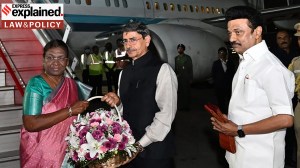Beas may change course to stretch Kullu runway
The Centre’s ambitious plan to expand the Bhuntar airport in Kullu in Himachal Pradesh is sure to raise the hackles of environmentalist...

The Centre’s ambitious plan to expand the Bhuntar airport in Kullu in Himachal Pradesh is sure to raise the hackles of environmentalists because expansion work, assigned to the Airports Authority of India (AAI), cannot be undertaken without diverting the course of the Beas river.
The AAI has three years to complete the work and the Centre’s ready to pick the tab. Prime Minister Atal Behari Vajpayee, while in Bhuntar on May 18, pledged Rs 30 crore for expansion of the airport so that ‘‘larger planes can land there.’’
But it’s easier said than done. The present length of the runway is 3,700 feet. It’s located in a narrow valley, surrounded by hills, and on the flood plains of the Beas. As of now, the runway is suitable for 18-seater aircraft like the Dornier. The Centre wants to extend it to 5,000 feet (plus a safety length of 300 feet) so that 60-70 seater ATR-72 aircraft can land at the airport.
While the intentions are good, it’s difficult in practice because 310 metres (around 1,000 feet) of the expanded runway will run into the Beas. In short, if the runway’s to be expanded then the course of the Beas will have to be diverted through a pilot channel into agriculture land on the opposite banks.
In May, 2001 the AAI had informed the Prime Minister’s Office (PMO) that a 1999 study by the Water Resource Development and Training Centre (WRDTC) of Roorkee University came to the conclusion that the Bhuntar task, though technically not infeasible, would be a costly affair.
The Roorkee team suggested:
• Diversion of the present flow of river water by construction of bed sills upstream side;
• Excavation of a pilot channel for re-channelising the flow of river towards the left bank side;
• Protection of the airport embankment from river erosion with reinforced concrete dykes;
• The total project cost in 1999 was estimated at Rs 59.20 crore.
The Ministry of Civil Aviation made it clear to the PMO that the existing runway could cater to a 50-seater aircraft and its expansion for a 60-70 seater aircraft at the cost of Rs 60 crore did not appear ‘‘attractive.’’ The Ministry instead favoured construction of a new Rs 1,000 crore-airport, saying there was no guarantee of the Beas being tamed despite all protection measures.
Given the Government interest, the AAI decided to sponsor another study on ‘‘training’’ Beas. But the Pune-based Central Water and Power Research Station (CWPRS), which conducted the study last year, came up with similar recommendations.
‘‘There’s a necessity of river training works for diversion of the entire river flow for a certain length and after the diversion of the flow, constant monitoring of the behaviour of the river during subsequent flood seasons should be recorded and studied,’’ the report stated. It was this report which made the Civil Aviation Ministry give up the idea of undertaking the project.
The AAI, on its part, put the ball in the Himachal Government’s court, saying they were willing to undertake runway expansion provided the State government gave them ‘‘the reclaimed land after diversion of Beas free of costs and free from all other encumberances (read environmental clearance).’’ But the Centre has now made it clear that it’s for the AAI to do the job.
Photos




- 01
- 02
- 03
- 04
- 05



























